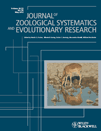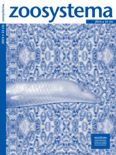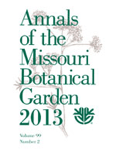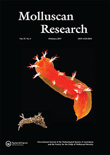
Bradleya
Scope & Guideline
Exploring the Depths of Horticultural Excellence
Introduction
Aims and Scopes
- Taxonomy and Systematics of Succulents:
The journal emphasizes the classification and naming of succulent plants, with a strong focus on cacti and Crassulaceae, providing new species descriptions and taxonomic revisions. - Conservation Strategies and Ecology:
Bradleya addresses conservation issues related to succulents, discussing both in-situ and ex-situ conservation approaches, and examines ecological factors influencing succulent distribution and survival. - Geographical Distribution and Biogeography:
Research often explores the geographical distribution of succulent species, highlighting endemic species and their conservation status in various regions, particularly in Africa and South America. - Cultivation and Horticulture:
The journal includes studies on the cultivation of succulent plants, examining their horticultural practices and the role of cultivation in conservation efforts. - Historical Perspectives and Illustrations:
Bradleya also delves into the historical aspects of succulent plants, including reviews of historical botanical illustrations and literature related to succulents.
Trending and Emerging
- Invasive Species and Naturalization:
There is an increasing focus on the status of invasive succulent species in various regions, particularly in North Africa and the British Isles, reflecting growing environmental concerns. - Ex-situ Conservation Techniques:
Emerging studies emphasize the importance of ex-situ conservation methods, including tissue culture and propagation techniques for endangered succulent species. - Ecological Interactions:
Research is increasingly exploring the ecological relationships between succulents and their pollinators or other organisms, indicating a trend towards understanding broader ecological dynamics. - Impact of Climate Change:
Recent publications are starting to address the impacts of climate change on succulent species, examining how changing environmental conditions affect their distribution and survival. - Cultural and Historical Significance:
There is a growing interest in the cultural and historical significance of succulents, as evidenced by studies on historical texts and illustrations related to these plants.
Declining or Waning
- General Flora Studies:
There has been a noticeable decrease in papers focusing on broader flora studies that do not specifically address succulents, suggesting a tightening of the journal's focus on succulent-specific research. - Traditional Horticultural Practices:
Research related to traditional horticultural practices has diminished, possibly as the focus shifts towards more scientific and conservation-oriented studies. - Morphological Studies without Ecological Context:
Papers that primarily focus on morphological characteristics of succulents without linking to ecological or conservation implications have become less frequent.
Similar Journals

COLEOPTERISTS BULLETIN
Connecting Researchers through Beetle InsightsCOLEOPTERISTS BULLETIN is a pivotal journal in the field of insect science, particularly focusing on the fascinating world of beetles. Published by the COLEOPTERISTS SOC, this journal disseminates high-quality research, illustrations, and literature reviews since its inception, with contributions spanning from 1988 to 2024. Though classified in Q3 of the insect science category as per the 2023 quartiles, it holds significant value for researchers, professionals, and students alike, offering insights into agricultural and biological sciences with an emphasis on coleopteran diversity and ecology. Based in the United States at the University of Georgia, this journal serves as a hub for scientific dialogue and advancements in the field. While it currently does not offer open access, its rigorously peer-reviewed articles ensure that cutting-edge research reaches a dedicated audience, promoting a deeper understanding of beetles' ecological roles and contributions to biodiversity.

Asian Myrmecology
Advancing Knowledge on Ant Biodiversity and EcologyAsian Myrmecology, published by University Malaysia Sabah, stands as a prominent platform within the field of myrmecology, focusing on the extensive research and study of ants and their impact on ecosystems across Asia. Established in 2008, this journal has become an essential resource, offering valuable insights into the evolutionary, ecological, and behavioral aspects of ant species, supported by its Q3 ranking in multiple relevant categories. With a commitment to open access, it aims to disseminate critical findings to researchers, students, and professionals, enhancing knowledge and fostering collaboration in the scientific community. The journal's scope, covering both ecological interactions and intricate systematics, is integral for advancing our understanding of biodiversity and environmental health in the region. By featuring original research, reviews, and case studies, Asian Myrmecology not only contributes to the academic dialogue but also strengthens the conservation efforts vital for sustaining ecosystems in Asia.

NORDIC JOURNAL OF BOTANY
Nurturing Collaboration in Botanical ResearchNORDIC JOURNAL OF BOTANY, published by WILEY, is a distinguished journal that serves as a vital platform for the dissemination of innovative research in the fields of Plant Science and Ecology, Evolution, Behavior and Systematics. With an ISSN of 0107-055X and E-ISSN 1756-1051, this journal has been a crucial part of the academic landscape since its inception in 1981, continuing to contribute significantly to the literature up to 2024. NORDIC JOURNAL OF BOTANY holds a commendable Q2 ranking in Plant Science and Q3 in Ecology, which underscores its impact and relevance in the scientific community. Despite the absence of Open Access options, the journal offers robust access features that ensure researchers and readers can easily engage with its meticulously curated content. Aimed at both seasoned professionals and emerging scholars, the journal not only publishes high-quality articles but also fosters collaboration and knowledge exchange across various related disciplines, thereby solidifying its role as a cornerstone in botanical and ecological research.

JOURNAL OF ZOOLOGICAL SYSTEMATICS AND EVOLUTIONARY RESEARCH
Connecting the Dots of Animal Science and EvolutionThe Journal of Zoological Systematics and Evolutionary Research, published by Wiley-Hindawi, stands as a premier academic journal since its establishment, showcasing cutting-edge research in the fields of Animal Science, Zoology, and Ecology. With an impressive track record spanning from 1963 to the present, this journal has earned a Q1 classification in both Animal Science and Ecology, as well as recognized rankings in Genetics and Molecular Biology. Its impact is highlighted by its Scopus ranks, placing it in the top percentile for relevant categories, underscoring its vital role in advancing knowledge and understanding within these disciplines. Researchers, professionals, and students will find a wealth of high-quality, peer-reviewed articles that contribute to the evolutionary understanding of biodiversity and systematics. Though not an Open Access journal, it remains accessible to a wide audience committed to exploring the intricacies of zoology and evolutionary biology.

JOURNAL OF CONCHOLOGY
Fostering Knowledge in ConchologyJOURNAL OF CONCHOLOGY, published by the Conchological Society of Great Britain & Ireland, is a prominent academic journal focused on the study of mollusks, specifically their taxonomy, ecology, and evolutionary biology. Through its rigorous peer-review process, it aims to provide a platform for significant research in the field, fostering deeper understanding and appreciation of these diverse organisms. Although it is not currently an Open Access journal, its publications contribute notably to the fields of Agricultural and Biological Sciences, notably in Ecology, Evolution, Behavior and Systematics and Aquatic Science, as indicated by its rankings in Scopus. The journal's archives trace comprehensive coverage from 1981 to 1990 and from 1996 to 2018. With its commitment to advancing conchological knowledge, the JOURNAL OF CONCHOLOGY serves as a crucial resource for researchers, professionals, and students invested in the biological and ecological dimensions of mollusk studies.

ZOOSYSTEMA
Exploring the Depths of Animal ScienceZOOSYSTEMA is a prestigious academic journal published by PUBLICATIONS SCIENTIFIQUES DU MUSEUM, PARIS, specializing in the fields of Animal Science, Zoology, and Ecology. With a focus on advancing the understanding of biodiversity and evolutionary processes, this journal serves as a vital platform for researchers to disseminate significant findings and foster discussions within the scientific community. Boasting an impressive categorization in the Q2 Quartile rankings for both its primary fields, ZOOSYSTEMA is recognized for its impact and quality, as indicated by its notable positions in the Scopus rankings. While currently not Open Access, the journal provides essential insights and comprehensive reviews across its volumes published since 1998, making it a cornerstone in zoological and ecological research. Researchers, professionals, and students alike will find ZOOSYSTEMA an invaluable resource for understanding complex biological systems and their interrelations, contributing to informed conservation and management efforts globally.

ACTA ZOOLOGICA ACADEMIAE SCIENTIARUM HUNGARICAE
Unveiling the Mysteries of Animal LifeACTA ZOOLOGICA ACADEMIAE SCIENTIARUM HUNGARICAE, published by the Hungarian Natural History Museum, is a distinguished open access journal dedicated to advancing knowledge across the fields of Animal Science, Zoology, Ecology, Evolution, Behavior, and Systematics. Established in 2003 as an open access platform, this scholarly journal has actively contributed to the dissemination of critical research since 1996, positioning itself within the Q3 quartile in both its primary fields as of 2023. With its ISSN 1217-8837, ACTA ZOOLOGICA serves as a vital resource for researchers, professionals, and students aiming to explore and expand their understanding of animal biodiversity and ecology. Its publication features a variety of empirical studies, reviews, and critical commentaries that rigorously address contemporary issues in zoological sciences, underlining its commitment to fostering academic excellence and environmental sustainability. Researchers can access the journal’s extensive archives to deepen their inquiry into animal life, making it an essential addition to any academic library.

ANNALS OF THE MISSOURI BOTANICAL GARDEN
Illuminating the Science of Plants and Their EcosystemsANNALS OF THE MISSOURI BOTANICAL GARDEN is a prestigious, peer-reviewed journal published by the Missouri Botanical Garden, focusing on the rich disciplines of Ecology, Evolution, Behavior, and Plant Science. With a storied history dating back to 1946, this journal has evolved to become a significant platform for scholars and professionals to disseminate research that informs global understanding of plant biology and conservation. Ranked in the Q2 category for both Ecology and Plant Science in 2023, it boasts commendable standings within the Scopus rankings, placing it in the 66th percentile for Plant Science and the 65th percentile for Ecology, Evolution, Behavior, and Systematics. The journal's commitment to rigorous scientific standards ensures that it remains a vital resource for those seeking to explore vital ecological and botanical research. As a product of the esteemed Missouri Botanical Garden, the journal serves researchers, professionals, and students alike, encouraging collaboration and innovation in the plant sciences community.

PHYTON-ANNALES REI BOTANICAE
Nurturing the future of ecological research.PHYTON-ANNALES REI BOTANICAE is a distinguished journal dedicated to the fields of plant science and ecology, published by Ferdinand Berger Soehne. With its origins tracing back to 1994, this journal has carved a niche in disseminating vital research findings and innovative studies pertaining to botany and environmental biology, despite its coverage being discontinued in Scopus since 2016. The journal's impact extends across various disciplines, reflected in its rankings within the categories of Agricultural and Biological Sciences and Environmental Science, underscoring its commitment to advancing knowledge in plant sciences. While it is not an open-access journal, its rigorous peer-review process ensures high-quality research that is valuable for researchers, professionals, and students alike. Located in Horn, Austria, PHYTON serves as a pivotal platform for sharing significant contributions to the field, fostering a deeper understanding of plant biology and ecology.

MOLLUSCAN RESEARCH
Exploring the Depths of Molluscan DiversityMolluscan Research is a distinguished journal dedicated to advancing the field of molluscan science, covering a broad spectrum of topics including taxonomy, ecology, evolutionary biology, and conservation. Published by Taylor & Francis Ltd, this journal has been a crucial resource for researchers from its inception in 1987 up to 2024, significantly contributing to the understanding of molluscan species and their roles in various ecosystems. With an impressive impact factor and recognized within the Q3 quartile rankings in Animal Science and Zoology and Ecology, Evolution, Behavior and Systematics, as well as Q4 in Genetics, Molluscan Research serves as a vital platform for dissemination of high-quality original research and reviews. While it does not currently offer Open Access options, the journal remains accessible through institutional subscriptions, fostering collaboration and knowledge-sharing among researchers, professionals, and students across the globe.